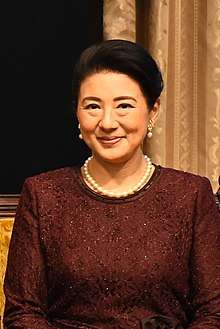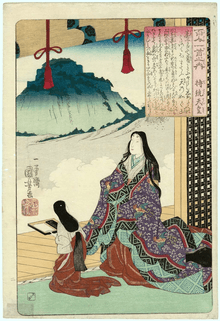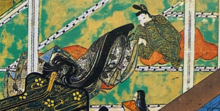Empress of Japan
Empress of Japan or Japanese Empress means an empress consort (皇后, kōgō). The current empress consort is Empress Masako, ascending on 1 May 2019. The term can also mean a female imperial ruler (女性天皇, josei tennō, also 女帝 jotei).
| Empress of Japan | |
|---|---|
| 皇后 | |
Imperial | |
gou_Flag.svg.png) | |
| Incumbent | |
 | |
| Masako since 1 May 2019 | |
| Details | |
| Style | Her Imperial Majesty/Her Majesty |
| Residence | Tokyo Imperial Palace as official residence |
| Website | The Imperial Household Agency |
Empress regnant

There were eight female imperial reigns (six female emperors including two who reigned twice) in Japan's early history between 593 and 770, and two more in the early modern period (Edo period). Although there were eight reigning empresses, with only one exception their successors were selected from amongst the males of the paternal Imperial bloodline.[1] After many centuries, female reigns came to be officially prohibited only when the Imperial Household Law was issued in 1889 alongside the new Meiji Constitution.
The eight historical empresses regnant are:
- Nukatabe, Empress Suiko (推古天皇 Suiko Tennō) was the 33rd empress of Japan from 593 until 628, according to the traditional order of succession, and the first historically attested woman to hold this position. She was the granddaughter of Tashiraga of Yamato, herself sister of the childless Emperor Buretsu, transferring some legitimacy in succession to the throne of Yamato to her husband Emperor Keitai. Tashiraga's mother had been Kasuga of Yamato, sister of the childless Emperor Seinei, whose own marriage with the future Emperor Ninken had a similar effect a generation earlier. According to legends, these ladies descended from the legendary Empress Jingū, who had been ruler (since Meiji-era rewrites of history, Regent) of Yamato for decades at some time in the past, probably in the mid-4th century (if she really existed), and who herself descended, according to legends, from Amaterasu omikami, the Sun Goddess of the Japanese pantheon.
- Takara, Empress Kōgyoku (皇極天皇 Kōgyoku Tennō), also Empress Saimei (斉明天皇 Saimei Tennō) was the 35th and 37th empress of Japan, initially from February 18, 642, to July 12, 645, ascending upon the death of her uncle Emperor Jomei (who had also been her second husband). When she abdicated, her own younger brother succeeded her. However, upon the death of the said younger brother, she reascended the throne as Empress Saimei on February 14, 655, and ruled until her death on August 24, 661. She was succeeded by her and Emperor Jomei's son, Naka no Ōe, as Emperor Tenji.
- Unonosasara, Empress Jitō (持統天皇 Jitō Tennō) was the 41st imperial ruler of Japan, and ruled from 686 until 697. The previous emperor was her uncle and husband, Emperor Tenmu, and she later abdicated the throne to her grandson Emperor Monmu.
- Ahe, Empress Genmei (also Empress Genmyō; 元明天皇 Genmei Tennō) was the 43rd imperial ruler of Japan ruling 707–715 (died December 7, 721). She was Empress Jitō's younger half-sister and the mother of Emperor Monmu, who died in an young age.
- Hitaka, Empress Genshō (元正天皇 Genshō Tennō) was the 44th monarch of Japan (715–724). She succeeded after her mother Empress Genmei and later abdicated to her nephew Emperor Shōmu, son of Emperor Monmu.
- Abe, Empress Kōken (孝謙天皇 Kōken Tennō) also Empress Shōtoku (称徳天皇 Shōtoku Tennō) was the 46th imperial ruler of Japan from 749 to 758, and the 48th from 764 to 770. Her posthumous name for her second reign (764–770) was Empress Shōtoku. She never married and her ex-crown prince was Prince Bunado, her first cousin twice removed, but after her death, another of her cousins ascended the throne as Emperor Kanmu, who was also her brother-in-law.
- Okiko, Empress Meishō (明正天皇 Meishō Tennō) was the 109th empress of Japan, reigning from December 22, 1629, to November 14, 1643. She ascended upon the abdication of her father, being the eldest surviving child of her parents (the empress, Tokugawa Masako, had only four daughters without surviving sons), holding priority over her younger half-brothers.
- Toshiko, Empress Go-Sakuramachi (後桜町天皇 Go-Sakuramachi Tennō) was the 117th empress of Japan, and ruled from September 15, 1762, to January 9, 1771. She abdicated in favor of her young nephew. Surviving over forty years, the retired Empress held all those decades the position of Dajo Tenno, and acted as sort of guardian of subsequent emperors.
Other than the eight historical empresses regnant, two additional empress is traditionally believed to have reigned, but historical evidence for her reign is scant and she is not counted among the officially numbered Emperors:
- Empress Jingū r. 206–269 (Empress Consort of Emperor Chūai)—not counted among the officially numbered Emperors
- Iitoyo: Imperial princess and possibly empress regnant. She was baptized as Empress Tsunuzashi in the list of emperors of Japan, written by Ernest Mason Satow
Under Shinto religious influence, the goddess Amaterasu, who is of the highest rank in the kami system, might suggest that Japan's first rulers were women.[2] According to the Kojiki and Nihon Shoki chronicles in Japanese mythology, the Emperors of Japan are considered to be direct descendants of Amaterarasu.
Empress consort

In ancient Japan, most of the empresses consort were princesses, except for Iwa no hime (empress consort of Nintoku). After Empress Kōmyō (empress consort of Shōmu), daughters of Fujiwara clan or other clans could become empresses consort. Originally Chūgū (中宮) meant the palace for Kōgō, Kōtaigō (皇太后) (Empress Mother/Empress Dowager), or Tai-Kōtaigō (太皇太后) (Grand Empress Mother/Grand Empress Dowager). Until mid-Heian Period, Emperor had only one empress consort, and empress consort was also called Chūgū. Since Emperor Ichijō, because some Emperors had two empresses Consort, one of them was called Kōgō and another one was called Chūgū. After maiden Princess Yasuko became Kōgō as the mother-in-law (准母) of Emperor Horikawa, maiden princesses also became Kōgō.
List of non-reigning empresses
Kōgō is the title of a non-reigning empress consort. The title, still in use, is generally conferred on an emperor's wife who had given birth to the heir to the throne.[3] The title was first awarded posthumously in 806 to the late mother of Emperor Heizei.[4]
Chūgū was a term which evolved during the Heian period; and it came to be understood as the title of the empress. For a time, chūgū replaced kōgō; and then the titles became interchangeable.[5]
The numbers of kōgō varied, but there was only one Chūgū at a time.[6]
The title kōtaigō was given to the wife of an ex-emperor; and the title tai-kōtaigō came to be used by a dowager empress.[5]
- Ōtomo no Koteko (大伴小手子),[7] also known as Otehime (小手姫),[8] empress-consort of Emperor Sushun, 587–592
- Yamato Hime no Ōkimi (倭姫王), empress-consort of Emperor Tenji, 661–671
- Princess Tōchi (十市皇女) (648–678), empress-consort of Emperor Kōbun, 671–672
- Empress Kōmyō (光明皇后) (701–760), empress-consort of Emperor Shōmu, 730–749
- Princess Inoe (井上内親王) (717–775), empress-consort of Kōnin 770–772 (deposed)
- Fujiwara no Otomuro (藤原乙牟漏) (760–790), empress of Kammu 783–790
- Fujiwara no Taishi/Tarashiko (藤原帯子) (?–794), empress of Emperor Heizei (posthumous honor in 806)[4]
- Tachibana no Kachiko (橘嘉智子) (786–850), Empress of Saga 815–823
- Princess Seishi (正子内親王) (810–879), empress of Junna 827–833
- Princess Koshi (高志内親王) (789–809), empress of Junna (posthumous honor in 823)
- Fujiwara no Onshi (藤原穏子) (885–954), empress of Daigo 923–930
- Fujiwara no Anshi (藤原安子) (927–964), empress of Murakami 958–964
- Princess Masako (昌子内親王) (950–999), empress of Reizei 967–973
- Fujiwara no Kōshi (藤原媓子) (947–979), empress of Enyū 973–979
- Fujiwara no Junshi/Nobuko (藤原遵子) (957–1017), empress (kōgō) of Emperor En'yū 982–1000
- Fujiwara no Teishi (藤原定子) (977–1001), empress (chūgū) of Emperor Ichijō 990–1000, Empress (kōgō) of Ichijō 1000–1001
- Fujiwara no Shōshi (藤原彰子) (988–1074), Empress (chūgū) of Ichijō 1000–1012
- Fujiwara no Kenshi (藤原妍子) (994–1027), Empress (Chūgū) of Emperor Sanjō 1012–1018
- Fujiwara no Seishi (藤原娍子) (972–1025), Empress (Kōgō) of Sanjō 1012–1025
- Fujiwara no Ishi (藤原威子) (999–1036), Empress (Chūgū) of Emperor Go-Ichijō 1018–1036
- Princess Teishi (禎子内親王) (1013–1094), Empress (Chūgū) of Go-Suzaku 1037, Empress (Kōgō) of Emperor Go-Suzaku 1037–1051
- Fujiwara no Genshi (藤原嫄子) (1016–1039), Empress (Chūgū) of Go-Suzaku 1037–1039
- Princess Shōshi (章子内親王) (1026–1105), Empress (Chūgū) of Emperor Go-Reizei 1046–1068
- Fujiwara no Hiroko (藤原寛子) (1036–1127), Empress (Kōgō) of Go-Reizei 1051–1068, Empress (Chūgū) of Go-Reizei 1068–1068
- Fujiwara no Kanshi (藤原歓子) (1021–1102), Empress (Kōgō) of Go-Reizei 1068–1074
- Princess Kaoruko (馨子内親王) (1029–1093), Empress (Chūgū) of Go-Sanjō 1069–1074, Empress (Kōgō) of Go-Sanjō 1074–1093[9]
- Fujiwara no Kenshi (藤原賢子) (1057–1084), Empress (Chūgū) of Emperor Shirakawa 1074–1084
- Princess Teishi/Yasuko (媞子内親王) (1076–1096), Empress (Chūgū) as mother-in-law (准母) of Emperor Horikawa 1091–1093
- Princess Tokushi/Atsuko (篤子内親王) (1060–1114), Empress (Chūgū) of Horikawa 1093–1114
- Princess Reishi (令子内親王) (1078–1144), Empress (Kōgō) as mother-in-law (准母) of Emperor Toba 1108–1134
- Fujiwara no Shōshi/Tamako (藤原璋子) (1101–1145), Empress (Chūgū) of Toba 1118–1124
- Fujiwara no Kiyoko (藤原聖子) (1121–1182), Empress (Chūgū) of Emperor Sutoku 1130–1141
- Fujiwara no Yasuko (藤原泰子) (1095–1156), Empress (Kōgō) of Emperor Toba 1134–1139
- Fujiwara no Nariko (藤原得子) (1117–1160), Empress (Kōgō) of Toba 1142–1149
- Fujiwara no Tashi/Masaruko (藤原多子) (1140–1202), Empress (Kōgō) of Emperor Konoe 1150–1156
- Fujiwara no Teishi/Shimeko (藤原呈子) (1131–1176), Empress (Chūgū) of Konoe 1150–1156, Empress (Kōgō) of Emperor Konoe 1156–1158
- Fujiwara no Kinshi (藤原忻子) (1134–1209), Empress (Chūgū) of Go-Shirakawa 1156–1159, Empress (Kōgō) of Emperor Go-Shirakawa 1159–1172
- Princess Tōshi/Muneko (統子内親王), unmarried Empress (Kōgō) 1158–1159
- Princess Yoshiko (姝子内親王) (1141–1176), Empress (Chūgū) of Emperor Nijō 1159–1162
- Fujiwara no Ikushi (藤原育子), Empress (Chūgū) of Nijō 1162–1172, Empress (Kōgō) of Emperor Nijō 1172–1173
- Taira no Tokushi/Noriko (平徳子) (1155–1214), Empress (Chūgū) of Emperor Takakura 1172–1181
- Princess Sukeko (亮子内親王) (1147–1216), Empress (Kōgō) as mother-in-law (准母) of Emperor Antoku and Emperor Go-Toba 1182–1187
- Fujiwara no Ninshi/Tōko (藤原任子) (1173–1240), Empress (Chūgū) of Go-Toba 1190–1200
- Princess Noriko (範子内親王) (1177–1210), Empress (Kōgō) as mother-in-law (准母) of Emperor Tsuchimikado 1198–1206
- Fujiwara no Reishi (藤原麗子) (1185–1243), Empress (Chūgū) of Tsuchimikado 1205–1210
- Princess Shōshi (昇子内親王) (1195–1211), empress (kōgō) as mother-in-law (准母) of Emperor Juntoku, 1208–1209
- Fujiwara no Ritsushi (藤原立子) (1192–1248), empress-consort (chūgū) of Emperor Juntoku, 1211–1222
- Princess Hōshi/Kuniko (邦子内親王) (1209–1283), Empress (Kōgō) as mother-in-law (准母) of Emperor Go-Horikawa 1221–1224
- Fujiwara no Ariko (藤原有子) (1207–1286), empress-consort (chūgū) of Emperor Go-Horikawa, 1223–1226; empress-consort (kōgō) of Go-Horikawa, 1226–1227
- Fujiwara no Coshi (藤原長子) (1218–1275), empress-consort (chūgū) of Go-Horikawa, 1226–1229
- Fujiwara no Shunshi/Yoshiko (藤原竴子) (1209–1233), empress-consort (chūgū) of Emperor Go-Horikawa, 1230–1233
- Princess Rishi (利子内親王) (1197–1251), Empress (Kōgō) as mother-in-law (准母) of Emperor Shijō 1233–1239
- Fujiwara no Kitsushi/Yoshiko (藤原姞子) (1225–1292), Empress (Chūgū) of Emperor Go-Saga 1242–1248
- Princess Teruko (曦子内親王) (1224–1262), unmarried Empress (Kōgō) 1248–1251
- Fujiwara no Kōshi/Kimiko (藤原公子) (1232–1304), Empress (Chūgū) of Emperor Go-Fukakusa 1257–1259
- Fujiwara no Saneko (藤原佶子) (1245–1272), Empress (Chūgū) of Kameyama 1261, Empress (Kōgō) of Emperor Kameyama 1261–1272
- Fujiwara no Kishi (藤原嬉子) (1252–1318), Empress (Chūgū) of Emperor Kameyama 1261–1268
- Princess Reishi (姈子内親王) (1270–1307), unmarried Empress (Kōgō) 1285–1291
- Fujiwara no Shōshi (1271–1342), Empress (Chūgū) of Emperor Fushimi 1288–1298
- Fujiwara no Kinshi (藤原忻子) (1283–1352), Empress (Chūgū) of Emperor Go-Nijō 1303–1310
- Princess Shōshi (奬子内親王,達智門院) (1286–1348), unmarried Empress (Kōgō) 1319
- Saionji no Kishi (西園寺禧子,禮成門院) (1303–1333), Empress (Chūgū) of Emperor Go-Daigo 1319–1333
- Princess Junshi (珣子内親王,新室町院) (1311–1337), Empress (Chūgū) of Emperor Go-Daigo 1333–1337
- unknown, Empress (Chūgū) of Emperor Chōkei
- Minamoto no Masako (德川和子,東福門院) (1607–1678), Empress (Chūgū) of Emperor Go-Mizunoo 1624–1629
- Takatsukasa Fusako (鷹司房子,新上西門院) (1653–1712), Empress (Chūgū) of Emperor Reigen 1683–1687
- Princess Yukiko (幸子女王,承秋門院) (1681–1720), Empress (Chūgū) of Emperor Higashiyama 1708–1710
- Princess Yoshiko (欣子内親王,新清和院) (1779–1846), empress-consort (Chūgū) of Emperor Kōkaku 1794–1820
- Takatsukasa Tsunako (鷹司繋子,新皇嘉門院) (1798–1823), Empress (Kōgō) of Ninkō (posthumous honor in 1824)
- Empress Eishō (九條夙子,英照皇太后), empress-consort of Emperor Kōmei
- Empress Shōken (一條美子,昭憲皇太后), empress-consort of Emperor Meiji
- Empress Teimei (九條節子,貞明皇后), empress-wife of Emperor Taishō
- Empress Kōjun (久邇宮良子女王,香淳皇后), empress-wife of Emperor Shōwa
- Michiko Shōda (正田美智子), empress-wife of the 125th Emperor of Japan Akihito
- Masako Owada (小和田雅子), empress-wife of the 126th and current Emperor of Japan Naruhito
See also
- Himiko
- Taiyoo
- Imperial House of Japan
- Japanese imperial succession controversy
- Dayang Kalangitan
- Kōkyū
- List of Nyoin
- List of female castellans in Japan
References
- "Life in the Cloudy Imperial Fishbowl", Japan Times. March 27, 2007.
- Roberts, Jeremy, 1956- (2010). Japanese mythology A to Z (2nd ed.). New York, NY: Chelsea House Publishers. ISBN 9781438128023. OCLC 540954273.CS1 maint: multiple names: authors list (link)
- Nussbaum, Louis-Frédéric. (2005). "Kōgō" in Japan Encyclopedia, p. 543, p. 543, at Google Books.
- Ponsonby-Fane, Richard. (1959). The Imperial Family, p. 318.
- Nussbaum, "Chūgū" at p. 127, p. 127, at Google Books.
- Ponsonby-Fane, pp. 300–302.
- Jochi Daigaku. (1989). Monumenta Nipponica, Vol. 44, p. 455.
- Kawamata municipal website: 絹製品 Archived 2008-04-03 at the Wayback Machine
- Ponsonby-Fane, Richard. (1915). The Imperial Family of Japan, p. x.